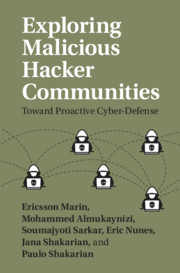
-
Select format
-
- Publisher:
- Cambridge University Press
- Publication date:
- 09 April 2021
- 29 April 2021
- ISBN:
- 9781108869003
- 9781108491594
- Dimensions:
- (229 x 152 mm)
- Weight & Pages:
- 0.44kg, 200 Pages
- Dimensions:
- Weight & Pages:
- Subjects:
- Criminology, Computer Science, Communications, Information Theory and Security, Sociology
You may already have access via personal or institutional login- Subjects:
- Criminology, Computer Science, Communications, Information Theory and Security, Sociology
Book description
Malicious hackers utilize the World Wide Web to share knowledge. Analyzing the online communication of these threat actors can help reduce the risk of attacks. This book shifts attention from the defender environment to the attacker environment, offering a new security paradigm of 'proactive cyber threat intelligence' that allows defenders of computer networks to gain a better understanding of their adversaries by analyzing assets, capabilities, and interest of malicious hackers. The authors propose models, techniques, and frameworks based on threat intelligence mined from the heart of the underground cyber world: the malicious hacker communities. They provide insights into the hackers themselves and the groups they form dynamically in the act of exchanging ideas and techniques, buying or selling malware, and exploits. The book covers both methodology - a hybridization of machine learning, artificial intelligence, and social network analysis methods - and the resulting conclusions, detailing how a deep understanding of malicious hacker communities can be the key to designing better attack prediction systems.
Contents
Metrics
Altmetric attention score
Full text views
Full text views help Loading metrics...
Loading metrics...
* Views captured on Cambridge Core between #date#. This data will be updated every 24 hours.
Usage data cannot currently be displayed.
Accessibility standard: Unknown
Why this information is here
This section outlines the accessibility features of this content - including support for screen readers, full keyboard navigation and high-contrast display options. This may not be relevant for you.
Accessibility Information
Accessibility compliance for the PDF of this book is currently unknown and may be updated in the future.


